Double Exposure Portrait Photography: Tips, Ideas & How to Get Started
A double-exposure portrait is a magnificent way to insert creativity into photography. By layering the two images, you've got the leverage to arrange a portrait with a textured shot or a scenic shot, as you can create the artistic and ethereal results.
This effect used to require film photography trickery, but now things have changed, and this type of effect is quite achievable with digital editing tools or a modern camera. Thus, if you're looking to create surreal cityscape profiles or dreamy forest silhouettes, this guide will take you through all the details about double exposure portraits.
Part 1. What is a Double Exposure Portrait?
A double exposure portrait remains a visual technique where the two images are superimposed to produce a single image. Typically, one photo is a profile or a person or a silhouette, and the second image tends to feature a natural element or an abstract, like a cityscape, clouds, or forests. This method tends to blend the storyline with the visuals and evoke the fantasy, symbolism, and emotion. Initially created using film photography, the techniques have been reshuffled with digital tools, offering artists more control and flexibility.

Part 2. How to Create a Double Exposure Portrait
1. Option A: In-Camera Techniques
Many mirrorless and DSLR cameras have built-in multiple exposure modes. This method creates the final image in the camera without needing the software, offering a more experimental and organic feel.
Cameras That Support Multi- Exposure- Canon EOS Series (e.g., Canon 5D Mark III, Canon R6)
- Nikon D-Series (e.g., Nikon D750, D850)
- Fujifilm X Series (e.g., Fujifilm X-T4, X, T5)
You can look at the guide below to capture the In-Camera double exposure
Step 1: Take the clean, front facing portrait, or high contrast profile. Side profiles or Silhouette work outstandingly for the overlaying.

Step 2: Select the second shot, including the texture, skyline, and forest. The camera lets you preview how the two will blend.
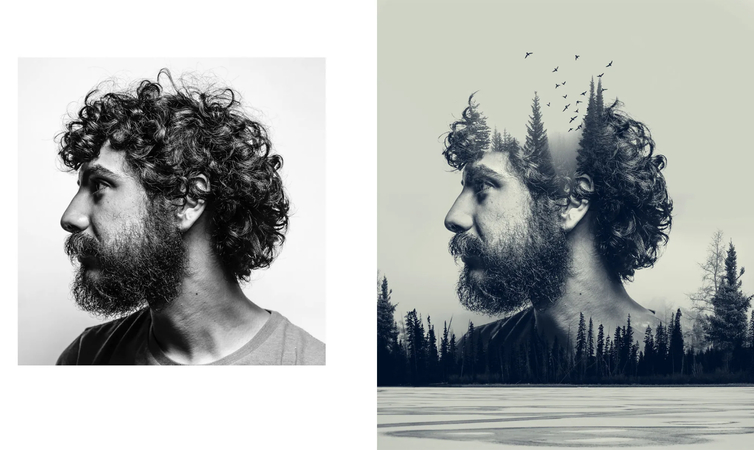
Step 3: Use the camera preview and exposure settings to fine-tune the alignment, contrast, and brightness of the images. Some models might also help you save both the blended images and the original images.
2. Option B: Post-Processing with Software
If your camera isn't compatible with multi-exposure or you're willing to attain creative control, you've got the leverage to produce double exposures using the photo editing software. You can opt for the tools like Adobe Photoshop, GIMP, Pixlr, or PicsArt. Since Adobe Photoshop is one of the most advanced and professional software, using it to create the double exposures will be worth admiring and breathtaking. You can look at the detailed guide below to make the double exposure portraits through Adobe Photoshop.
Step 1: Install Adobe Photoshop on the computer and start the tool before importing the two images into the screen. The photographs must then be dragged on top of each other. Over the pictures of the bison, drag the icy terrain. Then, you'll need to set the Blend mode in the Layers panel to reduce and screen the Opacity setting.
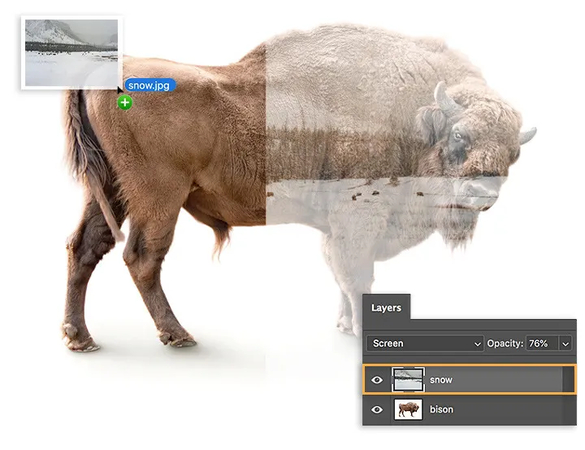
Step 2: To bring out the face of the bison and other areas, we've added the mask to the landscape layer. This lets you paint the areas where you want these details to show.
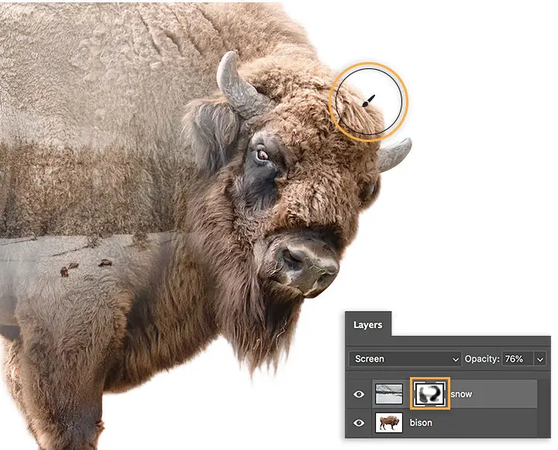
Step 3: You may also use the Violet, preset, and orange to build the Gradient Fill layer. Then, set the blend mode to overlay and lower the Opacity to 60% for a more dramatic effect.
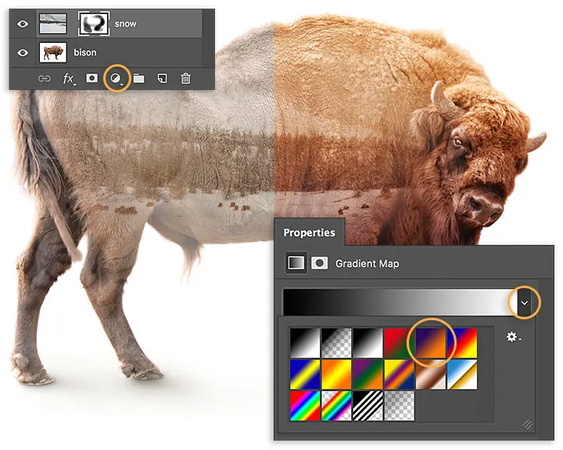
Step 4: To keep the focus on the face of the bison, you might adjust the Gradient Fill angle to 9 degrees. You can also tap on the gradient to launch the Gradient Editor and shift the violet color stop and color midpoint to attain the desired effects. You could also find pairs of images to combine in the photo gallery before having fun creating fresh takes.
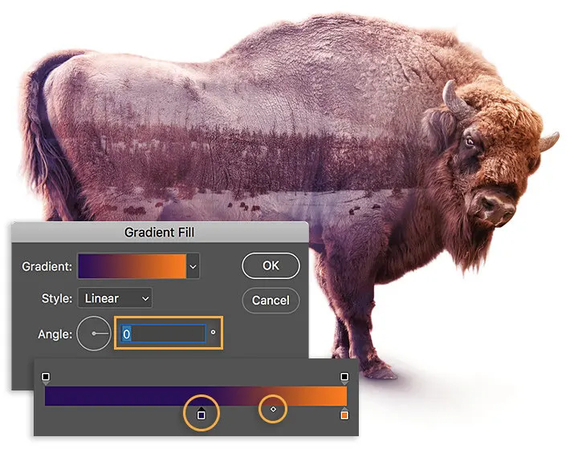
Part 3. Best Tool to Enhance Portrait with HitPaw FotorPea
Enhancing the quality of portraits is now only a few moments away, thanks to the outstanding features of HitPaw FotorPea. It provides an effortless user interface and 9 AI models to make it simpler for you to elevate the overall quality of the images. HitPaw FotorPea guarantees that the quality of the images is maintained while improving them by supporting watermark-free images.
Beyond that, HitPaw FotorPea also lets you enhance multiple photo portraits simultaneously, so if you want to colorize the black-and-white or would like to eradicate the blur from the pictures, you could upload several photos in one go.
Features
- Enhance the image portraits significantly
- Explore the 9 exciting AI models
- Provides a simple user interface
- No image quality loss found during image enhancing
- No watermark in the enhanced photos
- Enhance the multiple photos simultaneously
How can image portraits be enhanced through HitPaw FotorPea?
Step 1: To enhance the image portraits, access the software's website and tap on the Install icon. After installing the software, launch it and select the AI Enhancer option. You can then select Enhance Photos Now to import the images you wish to enhance the quality of. With HitPaw FotorPea, you can upload images in several formats as it is compatible with multiple formats.
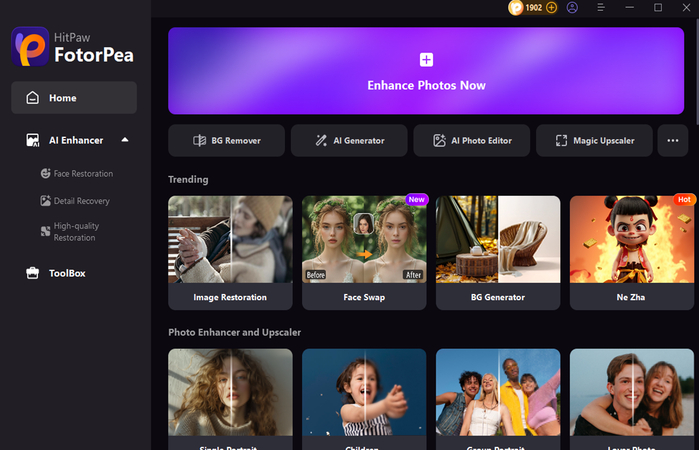
Step 2: After visiting the timeline of the HitPaw FotorPea, you'll be able to see 9 AI models. If you want to correct the details and appearance of the image portraits, choosing the Face Model is most recommended.

Step 3: Applying more than one AI model to the image portraits is also possible and after inserting the most anticipated AI model, you'll need to tap on the Preview button to see the changes Face model made to the images. Downloading the enhanced images is also possible by selecting the Export icon.

Part 4. FAQs of Double Exposure Portrait
Q1. What ISO is best for double exposure?
A1. It's recommended to use a low ISO for double exposure photography to maintain image clarity and avoid noise. Since you intend to combine two exposures, the overall photos happen to be brighter. Using a low ISO will ensure that the highlights don't get blown out, giving better control over contrast during the blending. If you want to shoot in the handheld or low light, you could increase the ISO slightly but always try to balance it with shutter speed and aperture to maintain quality.
Q2. Can iPhone camera do double exposure?
A2. While iPhone devices don't come with a built-in double exposure mode, you can still produce double exposure portraits by using apps like PicsArt, Snapseed, Fuses, and Photoshop Express. These apps will help you import two images before blending them using the masking and layer modes like in Adobe Photoshop.
Bottom Line
The fantastic art form of double exposure portrait photography combines the two pictures into a single expressive image. Whether you want to shoot in-camera by using the cameras like Nikon or Canon or would love to prefer the precision of the post editing tools like GIMP or Adobe Photoshop as heading for this way might bring the breathtaking results.
HitPaw FotorPea continues to be the most significant opportunity for those seeking to advance their careers. It allows you to enhance the images by applying the 9 AI models and to improve the quality of multiple photos in one go.




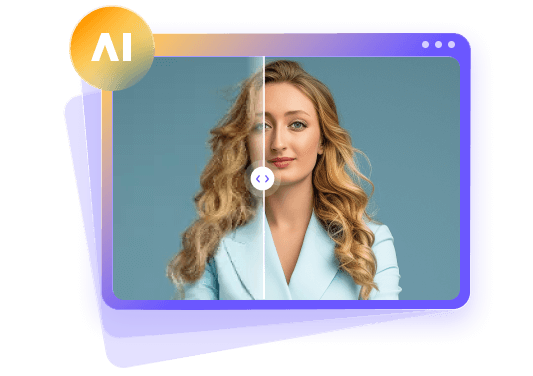





 HitPaw Edimakor
HitPaw Edimakor HitPaw VikPea (Video Enhancer)
HitPaw VikPea (Video Enhancer) HitPaw Univd (Video Converter)
HitPaw Univd (Video Converter) 



Share this article:
Select the product rating:
Daniel Walker
Editor-in-Chief
This post was written by Editor Daniel Walker whose passion lies in bridging the gap between cutting-edge technology and everyday creativity. The content he created inspires the audience to embrace digital tools confidently.
View all ArticlesLeave a Comment
Create your review for HitPaw articles